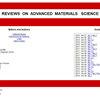Study on aging mechanism of SBS/SBR compound-modified asphalt based on molecular dynamics
IF 3.6
4区 材料科学
Q2 MATERIALS SCIENCE, MULTIDISCIPLINARY
引用次数: 0
Abstract
Abstract Component ratio change is considered to be the main reason leading to the deterioration of asphalt properties, but there are few studies on the aging mechanism from the perspective of modifier molecules. To reveal the aging mechanism of styrene–butadiene–styrene block copolymer (SBS)/styrene butadiene rubber (SBR) compound-modified asphalt, the micro mechanism in the aging process was studied by combining molecular dynamics (MD) and Fourier transform infrared spectroscopy (FTIR). First, MD was used to establish the micro models of SBS/SBR compound-modified asphalt at different aging stages (non-aging, short-term aging, and long-term aging) and to verify its rationality. Second, the micro characteristics of the SBS/SBR compound-modified asphalt micro model, such as solubility parameters, diffusion coefficient, interface interaction energy, and radial distribution function, were analyzed by calculation. Finally, the FTIR results proved the rationality of the simulation and explained the aging mechanism of SBS/SBR compound-modified asphalt. The results show that the cohesiveness density and solubility parameters of SBS/SBR compound-modified asphalt increase, the diffusion coefficient decreases, and the molecular interface stability increases during the aging process. And, the carbonyl index, sulfoxide index, and aromatic ring index increased in different degrees after aging. The study explains the aging mechanism of SBS/SBR compound-modified asphalt from the perspective of modifier molecules and provides a theoretical basis for the research of asphalt anti-aging.基于分子动力学的SBS/SBR复合改性沥青老化机理研究
组分比的变化被认为是导致沥青性能恶化的主要原因,但从改性剂分子的角度研究其老化机理的研究很少。为了揭示丁苯嵌段共聚物(SBS)/丁苯橡胶(SBR)复合改性沥青的老化机理,采用分子动力学(MD)和傅里叶变换红外光谱(FTIR)相结合的方法研究了老化过程中的微观机理。首先,利用MD建立了SBS/SBR复合改性沥青在不同老化阶段(非老化、短期老化和长期老化)的微观模型,验证了其合理性。其次,通过计算分析SBS/SBR复合改性沥青微观模型的溶解度参数、扩散系数、界面相互作用能、径向分布函数等微观特征;最后,FTIR结果证明了模拟的合理性,并解释了SBS/SBR复合改性沥青的老化机理。结果表明:在老化过程中,SBS/SBR复合改性沥青的黏结密度和溶解度参数增大,扩散系数减小,分子界面稳定性增强;陈化后羰基指数、亚砜指数和芳香环指数均有不同程度的升高。本研究从改性剂分子的角度解释了SBS/SBR复合改性沥青的老化机理,为沥青抗老化研究提供了理论依据。
本文章由计算机程序翻译,如有差异,请以英文原文为准。
求助全文
约1分钟内获得全文
求助全文
来源期刊

Reviews on Advanced Materials Science
工程技术-材料科学:综合
CiteScore
5.10
自引率
11.10%
发文量
43
审稿时长
3.5 months
期刊介绍:
Reviews on Advanced Materials Science is a fully peer-reviewed, open access, electronic journal that publishes significant, original and relevant works in the area of theoretical and experimental studies of advanced materials. The journal provides the readers with free, instant, and permanent access to all content worldwide; and the authors with extensive promotion of published articles, long-time preservation, language-correction services, no space constraints and immediate publication.
Reviews on Advanced Materials Science is listed inter alia by Clarivate Analytics (formerly Thomson Reuters) - Current Contents/Physical, Chemical, and Earth Sciences (CC/PC&ES), JCR and SCIE. Our standard policy requires each paper to be reviewed by at least two Referees and the peer-review process is single-blind.
 求助内容:
求助内容: 应助结果提醒方式:
应助结果提醒方式:


